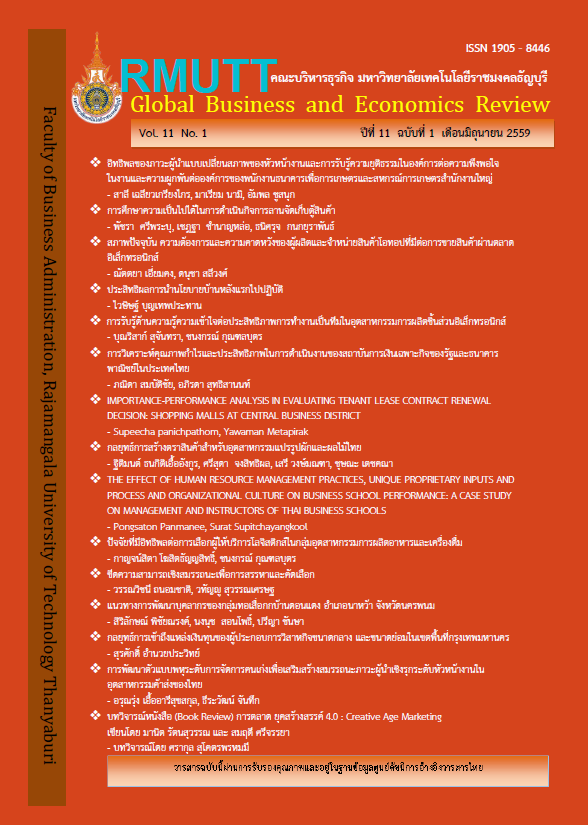CREATING BRAND STRATEGY FOR THAI FRUIT AND VEGETABLE PROCESSING INDUSTRY
Keywords:
Strategy, Brand, Brand Creating, Thai Fruit and Vegetable Processing IndustryAbstract
This study aimed at studying strategy of brand creating for the Thai fruit and vegetable processing industry. On qualitative research method, data were collected by the in-depth interview from four groups of key informants including 1) officials from government agencies, 2) brand creating experts and academicians, 3) entrepreneurs and 4) consumers who used the goods of such industry. A semi-structured interview was used. The data were organized and examined to confirm its reliability by using principle of data triangulation. This study was evaluated by focus group discussion, which selected the participants from people with knowledge about such brand creating officials from government agencies, brand creating experts and academicians, entrepreneurs, and consumers. It was found from the study that the brand creating strategy for the Thai fruit and vegetable processing industry was the strategy under the SMART PARADIGM which consisted of: S: Study – a data analysis associated with the business including consumer, competitor, industry, environment and ability; M: Management of strategic elements – management for setting directions and elements of brand including group of target customer, vision, point of win, promise, property, strong point, difference, name, logo, slogan, symbol, character, and packaging; A: Advantages – creating a competitive advantage through the strategic framework of brand creating including goods, price, distribution, marketing communication, personnel, and production; R: Relevance – creating a consistency to meet the needs of consumers on the basis of benefit and value that consumers would obtain; T: Trust – creating of faith, confidence and trustworthiness on basis of principle of recognition, connection, celebrity, image, and loyalty.
References
ดลชัย บุญยะรัตเวช. (2545). Brand Voice. กรุงเทพฯ: ทิปปิ้งพ้อยส์ เพรส.
ศิริกุล เลากัยกุล. (2546). สร้างแบรนด์. กรุงเทพฯ: อมรินทร์ พริ้นติ้งส์.
ศรีกัญญา มงคลศิริ. (2547). Brand Management. กรุงเทพฯ: ไฮน์เจอร์ เพรส.
สถาบันอาหาร. (2558). รายงานสถานการณ์อุตสาหกรรมอาหารไทยรายเดือน. ม.ป.ท.: สถาบันอาหาร.
สำนักงานคณะกรรมการพัฒนาการเศรษฐกิจและสังคมแห่งชาติ. (2555). แผนพัฒนาเศรษฐกิจและสังคมแห่งชาติฉบับที่ 11 พ.ศ. 2555-2559. กรุงเทพฯ: สำนักงานคณะกรรมการพัฒนาการเศรษฐกิจและสังคมแห่งชาติ สำนักนายกรัฐมนตรี.
สำนักงานเศรษฐกิจอุตสาหกรรม. (2552). แผนแม่บทอุตสาหกรรมอาหาร พ.ศ. 2553-2557.กรุงเทพฯ: สำนักงานเศรษฐกิจอุตสาหกรรม กระทรวงอุตสาหกรรม.
สำนักงานเศรษฐกิจอุตสาหกรรม. (2554). แผนแม่บทการพัฒนาอุตสาหกรรมไทย พ.ศ. 2555-2574. กรุงเทพฯ: สำนักงานเศรษฐกิจอุตสาหกรรม กระทรวงอุตสาหกรรม.
สำนักงานเศรษฐกิจอุตสาหกรรม. (2557). ปัญหาและอุปสรรคผู้ประกอบการอาหารไทย. อุตสาหกรรมสาร, 56(2), 34.
สุภางค์ จันทวานิช. (2554). วิธีการวิจัยเชิงคุณภาพ (พิมพ์ครั้งที่ 19). กรุงเทพฯ: ศูนย์หนังสือจุฬาลงกรณ์ มหาวิทยาลัย.
เสรี วงษ์มณฑา. (2548). ลุ่มลึกเรื่องการตลาด. กรุงเทพฯ: Good Communication.
เสรี วงษ์มณฑา, และชุษณะ เตชคณา. (2550). ลุ่มลึกกับแบรนด์. กรุงเทพฯ: ฐานบุ๊ค.
Aaker, D.A. (1991). Managing brand equity. New York: The Free Press.
Aaker, D.A. (1996). Building strong brand. New York: The Free Press.
Campbell, M.C. (2002). Building brand equity. International Journal of Medical Marketing, 2(3), 208-218.
Doyle, P. (2000). Valuing marketing contribution. European Management Journal, 3(18), 233-245.
Duncan, T. (2002). Using advertising and promotion to build brand. Boston: McGraw-Hill.
Erlandson, D. A., Harris, E. L., Skipper, B. L. & Allen, S. D. (1993). Doing naturalistic inquiry: A guide to methods. Newbury Park, CA: Sage.
Gad, T. (2001). 4-D Branding. Great Britain: Bookhouse Publishing.
Knapp, E. (2000). The brand mindset. New York: McGraw- Hall.
Kotler, P. (2002).Marketing Management (The Millennium Edition).Upper Saddle River., NJ : Prentice-Hall.
Kotler, P. (2003).Marketing Management (11 th ed).New Jersey, USA.: Pearson Education.
Lamb, Jr., Charles.W., Hair Jr. Joseph F., & McDanail, C. (1994). Principles of marketing. USA.: South-Western.
Light, L. (1993). Reinforce Loyalty to Your “Brand”. N.P.: n.p.
McDaniel, C. & Darden W. (1987). Marketing. USA.: Allyn and Bacon.
Miles, M. B. & Huberman, A. M. (1994). Qualitative data analysis. Thousand Oaks, CA: Sage.
Neumeier, M. (2003). The brand gap. Indiana: New Riders.
Spradley, J.P. (1979). The ethnographic interview. New York: Holt, Rinehart and Winston.
VanAuken, B. (2002). The brand management checklist. London: Kogan Page Limited.
Yastrow, S. (2003). Brand harmony. New York: Select Books Inc.
Downloads
Published
How to Cite
Issue
Section
License
The articles published in this journal are the intellectual property of their respective authors.
The views and opinions expressed in each article are solely those of the individual authors and do not reflect the positions of Rajamangala University of Technology Thanyaburi or any of its faculty members. All components and content of each article are the sole responsibility of the respective authors. In the event of any errors, the authors shall bear full responsibility for their own work.








